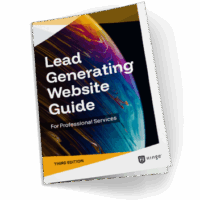Is your company’s website losing you new business? If you have any concerns, a website audit can provide clear guidance and a path forward.
There is no ignoring the staggering importance of website performance. To remain competitive, you need a website that clearly articulates your value proposition, demonstrates your experience and expertise, and generates high-quality leads.
But websites have a shelf life… To keep pace with changes in technology, buyer behavior, and the competitive landscape, every business must keep a pulse on the state of their website and have a plan for its continued development. This is where a website audit can help.
A website audit is a detailed assessment of your website’s performance. It is a comprehensive review of your website’s health, technical performance, user experience, design, messaging and how all these factors compare to your competitors.
At Hinge we have audited and designed hundreds of professional services websites. In this post we’re going to share exactly how we go about conducting a website audit for our clients along with some of the tools we use. If you choose to conduct your own website audit, we hope this article will be a helpful resource.
The 7 Components of a Website Audit
The goal of a website audit is to gain clarity on two fronts: 1) how well your website is at attracting and engaging your target audiences, and 2) how to improve performance. At the end of an audit you should have a clear idea of whether you need to make some relatively minor website modifications or undertake a complete website redesign.
Going back to the original question of this article, if you suspect that your website could be a reason you’re losing business to your competitors, then you need to know why this is happening. Is it simply because your website is older and makes your firm appear behind the times? Or is it something related to your positioning and messaging? Or perhaps a confusing user experience is making content difficult to find? A comprehensive website audit will shed light on the answers and direct you toward solutions.
Should you hire an outside firm or conduct the audit yourself? There are clear advantages of using an outside specialist. They will approach your situation without any bias or preconceptions. And they have special skills and tools to make the process more efficient and insightful. But it is possible to tackle the job yourself, too. Just be aware that you may have a few blind spots.
So here are the 7 areas we recommend exploring in a website audit:
1. Website Health and Technical Performance
Before we look at the front end of the website, we start our website audits with a series of health checks—examining everything from plugin health to overall site speed. Websites that are slow to load or have many broken links will inevitably have negative performance and user experience consequences. These problems are also likely to affect your ability to rank in search engines.
There are a number of tools out there you can use to evaluate your website health. One tool we use is SEMrush’s website site audit tool which checks over 140 on-page and technical SEO issues that could appear across your website.
However, for a technical website health analysis like this we recommend working with a seasoned partner with website development experience as a part of the process. Developers understand why something is broken and can tell you how much it will cost to fix it. A good partner will be candid about whether it’s better to fix all the issues or redesign the website.
Here are a few questions to ask about your website health and technical performance:
- Is my website mobile-friendly and responsive across all devices?
- How quickly does my website load on desktop and mobile?
- Are there any broken links or 404 errors on my website?
- Does my website have any security vulnerabilities (HTTPS, SSL certificate)?
- Is my website accessible to users with disabilities (WCAG compliant)?
- Are all forms and interactive elements functioning correctly?
- Is my website’s code clean, well-structured, and optimized for performance?
2. User Acquisition and Search Engine Optimization (SEO)
Once you have a grasp of your website’s technical health, you can begin to analyze your users. An exploration of user behavior should begin with an understanding of how users land on your website in the first place.
The data we gather here can be easily sourced from Google Analytics (now called Google Analytics 4 or GA4) and Google Search Console. We recommend you analyze a range of dates between six and twelve months to account for any seasonality that may occur in your industry. For example, it is common that we see accounting and CPA firm websites experience extra direct traffic from users during the springtime “busy months” due to clients returning to their website.
GA4 can also help you understand user acquisition. Are users coming directly to your website, or are they finding you through channels like organic search or social media. Understanding how users are getting to your website will give you insight into who your visitors are and what they may be looking for from your website.
For example, websites with a lot of direct traffic should be optimized for returning visitors. Perhaps your website features a client portal. Is this easy to access, or does it require more than two clicks to find?
Additionally, you want to understand your top landing pages from GA4. The most popular landing pages on your website are ones that should demand more of your attention. For many of you this may be your homepage—but that is not always the case. Regardless of which pages are your top landing pages, you must recognize that the messaging, photography, and page design of these pages is going to make an important first impression on your users.
Next turn to Google Search Console (GSC). If there is one tool that is underutilized by professional services marketers today, I’d say it is GSC. For companies that are serious about improving their visibility on search engines like Google, GSC is an invaluable tool in understanding exactly what queries people are using to find your website. In the example below, you can see the top keywords users are searching to find Hinge’s website within a three month period.

We recommend you increase your familiarity with Google Search Console. In your website audit, it is vital to understand which pages are performing and underperforming in terms of SEO. Dive deep into the data and make a list of pages where there is opportunity to improve SEO performance. Document your changes and monitor progress from there.
Questions to answer on user acquisition and SEO:
- What are my top traffic sources (organic search, direct, referral, social)?
- Which keywords are driving the most organic traffic to my website?
- Are my website’s title tags and meta descriptions optimized for relevant keywords?
- Does my website have a clear sitemap and robots.txt file for search engines?
- Am I actively building high-quality backlinks to my website?
3. User Behavior
Now that you have identified your website’s primary landing, you need to understand what actions users take next.
A certain (usually large) percentage of users will not take any action. They may bounce off of the website or stay on the page without taking any action. To measure this behavior, look in Google Search Console at each page’s engagement rate. According to Orbit Media, the average engagement rate is 55%. So pages that fall below this benchmark should be added to your list of pages to study closer.
In GA4’s path exploration feature, you can visualize which pages your users navigate to in your website. For example, for one of Hinge’s top blog posts, I can see what proportion of users are navigating to the different links included in the blog post. In this case, most are navigating to the Marketing Planning Guide that we’ve featured at the top of that blog post.

Another tool you can use to analyze user behavior is Hotjar or one of its competitors. These tools build heatmaps that show how your users engage with your web pages. They can even record sessions on your website that you can review and see exactly what a user clicked. In this way, you can collect very specific insights into which on-page elements are capturing user attention and which are being ignored.
Here are some questions to ask about user behavior:
- What is the engagement rate for my website’s key pages?
- How much time are users spending on my website per session?
- What are the most popular pages on my website?
- Are users navigating to pages that help position my firm’s capabilities?
- Which links in my navigation bar are being clicked?
4. User Experience and Engagement
A website isn’t a static brochure; it’s a dynamic environment designed to guide visitors toward deeper engagement with your business. In this stage of the audit, we shift our focus to the kind of content users can engage with on your website. Think of it as assessing the “stickiness” of your website.
When auditing your website’s user experience and engagement, there are a number of things to consider. But an important question you should ask yourself during your audit is, “What do I want my website visitors to do once they’ve read the content on this page?” Too often, professional services websites are built to offer few if any ways to dive deeper and discover new content.
Pages lacking these offer elements are dead ends, essentially encouraging visitors to leave your site rather than exploring further. A well-structured website anticipates user needs and proactively presents relevant content, creating a seamless and engaging journey.
Let’s use the example of a large engineering firm that has experience with building bridges. When a user lands on this page, what kind of relevant information could the firm include on this page aside from some webpage copy that says they build bridges? Here are some examples:
- Links to specific project portfolio pages that show the bridges they’ve designed
- Links to relevant thought leadership content on bridge design
- A featured expert who leads the bridge design practice
- A call to action to get in touch with an expert in bridge design
In your website audit, you need to use a combination of analytics and tools to assess how engaging your pages are for users. Part of this is intuitive. If there isn’t additional content on each one of your key pages then you’ll want to consider what kinds of modules you can develop across your website that help make your pages more interesting. These insights are crucial for identifying areas you can enhance the overall user experience.
Here are a few questions to ask about user experience and engagement:
- Does my website have clear and compelling calls to action (CTAs)?
- Am I using internal links to guide users to relevant content and resources?
- Is my website’s content engaging, informative, and valuable to my target audience?
- Am I using visuals and multimedia to enhance the user experience?
- Do I have a strategy for capturing leads and nurturing them through the sales funnel?
5. Brand Design
First impressions matter—and your website’s visual appeal plays a significant role in how your firm is perceived. This section of the audit focuses on the aesthetics of your website, evaluating how well it reflects current design trends and your brand identity.
You will examine the quality of the site’s imagery, your use of video, and the overall visual hierarchy. Does your website rely heavily on generic stock photography or does it feature unique, high-quality visuals that capture attention? Is video integrated strategically to tell your story and engage your visitors? Does the design feel modern and fresh or is it dated and out of touch?
Some visual elements you’ll want to pay special attention to include the following:
- Use of your firm’s logo, color palette, and brand style
- Overall readability of headlines, webpage copy, and buttons
- Featured photography and video, especially on your homepage
- Navigation design
- Iconography
- Custom backgrounds
A strong brand design goes beyond mere aesthetics. It communicates professionalism, credibility, and a distinct brand personality. A website audit should identify any visual elements that detract from your brand image or hinder user engagement.
Here are some questions to ask regarding brand design:
- Does my website’s design reflect my brand’s personality and design guidelines?
- Is my website visually appealing and easy to navigate?
- Am I using high-quality images and videos that are relevant to my content?
- Is my website’s typography clear, easy to read, and consistent with my brand?
- Does my website’s color palette align with my brand identity?
- Is my website’s design consistent across all pages and devices?
- Am I staying up-to-date with current web design trends and best practices?
6. Messaging
Your website is your most important tool for communicating your firm’s unique value proposition. Therefore, during your website audit it is essential that you assess the clarity, consistency, and effectiveness of your messaging.
We analyze website copy to ensure it resonates with your target audience and clearly articulates the benefits of working with your firm. Is the language compelling and persuasive? Does it differentiate your firm from competitors? Does it address the specific needs and pain points of your ideal clients?
Weak or generic messaging can cause your firm to blend into the background, failing to keep the attention of potential clients. A website audit should identify any messaging gaps or inconsistencies that dilute your brand message or hinder lead generation.
Here are some questions to ask regarding your website’s messaging:
- Does my website clearly communicate my firm’s value proposition?
- Is my website’s messaging targeted to my ideal client profile?
- Is my website’s language clear, concise, and persuasive?
- Am I using storytelling to connect with my audience and build trust?
- Does my website’s messaging differentiate my firm from competitors?
- Is my website’s content free of jargon and technical terms?
7. Competitive Analysis
In the final part of your website audit you will take all of your discoveries and contrast them against your key competitors. Understanding your competitive landscape is crucial for developing a successful website strategy. In this last stage of the audit, we turn our attention to your competitors, analyzing their online presence and identifying opportunities for differentiation.
At Hinge, we examine the website design, messaging, and SEO performance of a client’s top competitors. How are they positioning their services? What keywords are they targeting? What kind of content marketing techniques are they deploying? What are the opportunities to stand apart from them?
Competitive analysis helps you think big picture about your website design strategy. Solid marketplace intelligence equips you to make better, more confident decisions. We recommend you look at both your direct competitors as well as one or two large competitors who have robust marketing machines. Even though you may not be able to match industry leaders’ content output, you’ll have valuable insight into what your audience may expect.
Here are a few questions to ask about your competitors’ websites:
- How do the websites of my direct competitors compare to mine?
- What keywords are my competitors targeting and being found for?
- What are my competitors’ strengths and weaknesses in terms of their online presence?
- What can I learn from my competitors’ website design and messaging choices?
- Are there any opportunities to differentiate my firm from competitors?
What’s Next After the Website Audit?
Once you have completed your website audit you should have a clear understanding of how you should proceed. Either you will have a list of action items to improve, or you will understand why a website redesign is in your future.
It is possible for you to conduct your own website audit. If that is your goal, we hope this article has been helpful. If, however, after reading through the process and everything it entails, you realize that it is beyond your abilities, consider engaging a third-party specialist to do it for you. Your website plays a critical role in your business’ success, so it’s essential that you have all of the facts.
How does your website stack up? Now you know how to find out. And reach out if you need any help.
How Hinge Can Help
Hinge’s website audit services deliver an objective, comprehensive analysis of your website’s strengths and weaknesses, as well as a roadmap to turn it into a sophisticated marketing platform and dependable source of high-quality leads.





